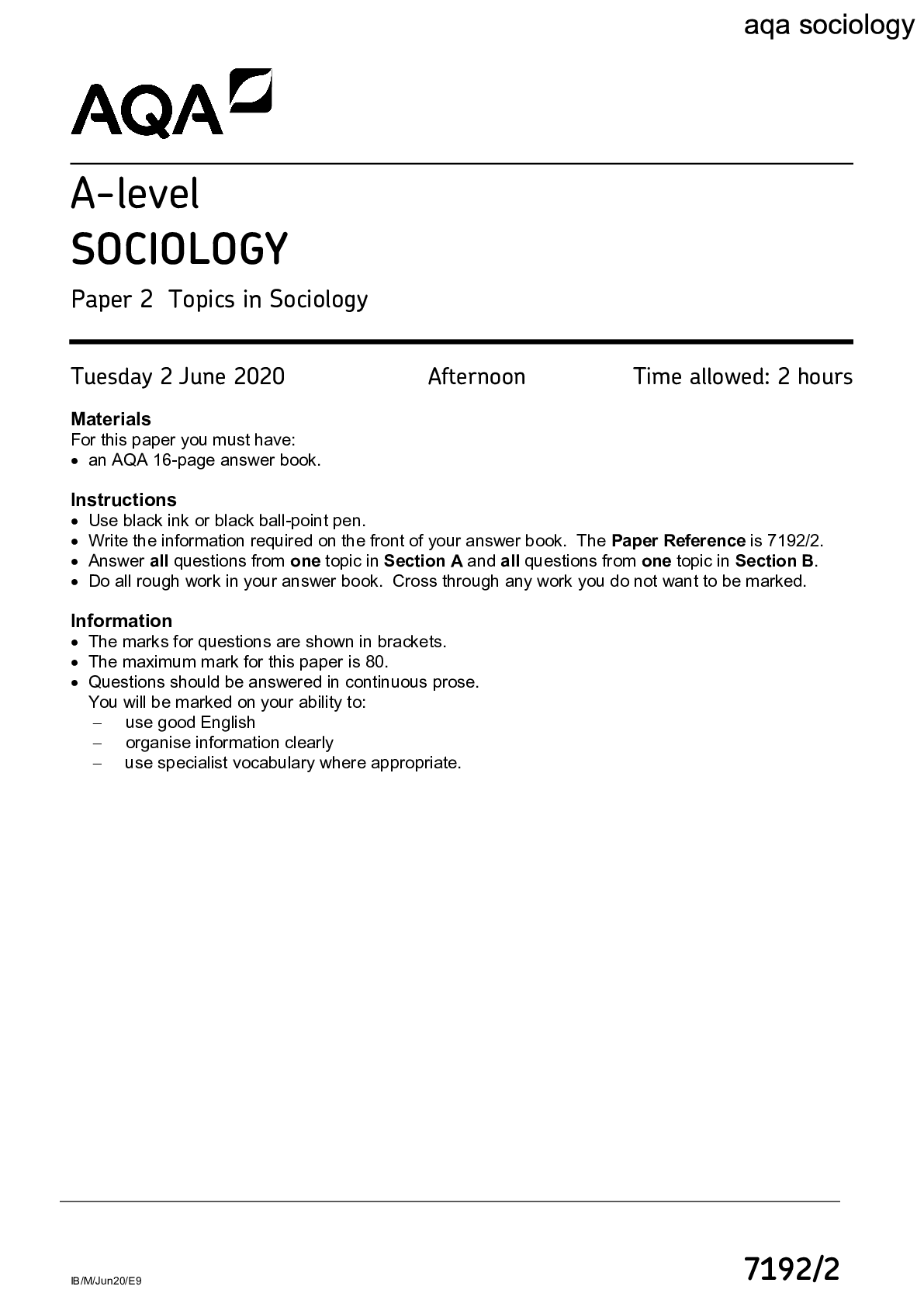Biology-AS-Level-7401-2-june 2021 marking scheme
Document Content and Description Below
Mark scheme instructions to examiners 1. General The mark scheme for each question shows: • the marks available for each part of the question • the total marks available for the question • ... the typical answer or answers which are expected • Extra information to help the examiner make his or her judgement and help to delineate what is acceptable or not worthy of credit or, in discursive answers, to give an overview of the area in which a mark or marks may be awarded. The extra information in the ‘Comments’ column is aligned to the appropriate answer in the lefthand part of the mark scheme and should only be applied to that item in the mark scheme. At the beginning of a part of a question a reminder may be given, for example: where consequential marking needs to be considered in a calculation; or the answer may be on the diagram or at a different place on the script. In general the right-hand side of the mark scheme is there to provide those extra details which confuse the main part of the mark scheme yet may be helpful in ensuring that marking is straightforward and consistent. 2. Emboldening 2.1 In a list of acceptable answers where more than one mark is available ‘any two from’ is used, with the number of marks emboldened. Each of the following bullet points is a potential mark. 2.2 A bold and is used to indicate that both parts of the answer are required to award the mark. 2.3 Alternative answers acceptable for the same mark are indicated by the use of OR. Different terms in the mark scheme are shown by a/; eg allow smooth/free movement. 3. Marking points 3.1 Marking of lists This applies to questions requiring a set number of responses, but for which students have provided extra responses. The general principle to be followed in such a situation is that ‘right + wrong = wrong’. Each error/contradiction negates each correct response. So, if the number of errors/contradictions equals or exceeds the number of marks available for the question, no marks can be awarded. However, responses considered to be neutral (often prefaced by ‘Ignore’ in the ‘Comments’ column of the mark scheme) are not penalised. MARK SCHEME – AS BIOLOGY – 7401/2 – JUNE 2021 4 3.2 Marking procedure for calculations Full marks can be given for a correct numerical answer, without any working shown. However, if the answer is incorrect, mark(s) can usually be gained by correct substitution/working and this is shown in the ‘Comments’ column or by each stage of a longer calculation. 3.3 Interpretation of ‘it’ Answers using the word ‘it’ should be given credit only if it is clear that the ‘it’ refers to the correct subject. 3.4 Errors carried forward, consequential marking and arithmetic errors Allowances for errors carried forward are most likely to be restricted to calculation questions and should be shown by the abbreviation ECF or consequential in the mark scheme. An arithmetic error should be penalised for one mark only unless otherwise amplified in the mark scheme. Arithmetic errors may arise from a slip in a calculation or from an incorrect transfer of a numerical value from data given in a question. 3.5 Phonetic spelling The phonetic spelling of correct scientific terminology should be credited unless there is a possible confusion with another technical term. 3.6 Brackets (…..) are used to indicate information which is not essential for the mark to be awarded but is included to help the examiner identify the sense of the answer required. 3.7 Ignore/Insufficient/Do not allow Ignore or insufficient is used when the information given is irrelevant to the question or not enough to gain the marking point. Any further correct amplification could gain the marking point. Do not allow means that this is a wrong answer which, even if the correct answer is given, will still mean that the mark is not awarded. MARK SCHEME – AS BIOLOGY – 7401/2 – JUNE 2021 5 Question Marking Guidance Mark Comments 01.1 Carboxyl; 1 Accept carboxylic acid Question Marking Guidance Mark Comments 01.2 Type of R group 1. Unsaturated (fatty acid/hydrocarbon); Explanation 2. Double bond (between carbons); 2 1. Accept alkene 2. Accept for ‘double bond’, C=C Question Marking Guidance Mark Comments 01.3 1. Add ethanol/alcohol then add water and shake/mix OR Add ethanol/alcohol and shake/mix then pour into/add water; 2. White/milky (emulsion) OR (emulsion) test turns white/milky; 2 1. Reject heating the emulsion test 1. Accept ‘Add Sudan III and mix’ 1. Ignore a second shake 2. Ignore cloudy 2. Reject precipitate 2. Accept (for Sudan III) top (layer) red MARK SCHEME – AS BIOLOGY – 7401/2 – JUNE 2021 6 Question Marking Guidance Mark Comments 01.4 (Similarity) 1. Both have a phospholipid bilayer OR Both have fatty acid/hydrophobic tails pointing in/face each other OR Both have phosphate/polar/hydrophilic heads pointing out OR Both have protein; (Differences) 2. No channel/carrier proteins, whereas fluid mosaic does OR Protein layer outside (phospholipids), fluid mosaic is 'dotted'; 3. Cholesterol is not present whereas it is present in fluid mosaic; 4. Glycoprotein is not present whereas it is present in fluid mosaic; 5. Glycolipid is not present whereas it is present in fluid mosaic; 3 max Accept 2 marks max if 1. is not achieved 2., 3., 4., and 5. accept first answer refers to 1935 model unless otherwise stated 2. Accept for ‘no channel/carrier’, no intrinsic 2. Accept only one type of protein whereas fluid mosaic has many (types) TOTAL 8 MARK SCHEME – AS BIOLOGY – 7401/2 – JUNE 2021 7 Question Marking Guidance Mark Comments 02.1 Mark in pairs: 1 and 2 OR 3 and 4 1. Flattened cells OR Single layer of cells; 2. Reduces diffusion distance/pathway; 3. Permeable; 4. Allows diffusion of oxygen/carbon dioxide; 2 1. Reject thin cell wall/membrane 1. Accept thin cells 1. Accept ‘one cell thick’ 4. Ignore gas exchange Question Marking Guidance Mark Comments 02.2 Correct answer for 2 marks = 1.10–1.15;; Accept for 1 mark, 0.6(1) : 1 (correct FEV1 : FEC ratio) 2 Question Marking Guidance Mark Comments 02.3 1. Less carbon dioxide exhaled/moves out (of lung) OR More carbon dioxide remains (in lung); 2. (So) reduced diffusion/concentration gradient (between blood and alveoli); 3. Less/slower movement of carbon dioxide out of blood OR More carbon dioxide stays in blood; [Show More]
Last updated: 2 years ago
Preview 1 out of 18 pages

Buy this document to get the full access instantly
Instant Download Access after purchase
Buy NowInstant download
We Accept:

Reviews( 0 )
$8.00
Can't find what you want? Try our AI powered Search
Document information
Connected school, study & course
About the document
Uploaded On
Jun 29, 2022
Number of pages
18
Written in
Additional information
This document has been written for:
Uploaded
Jun 29, 2022
Downloads
0
Views
125



.png)

















